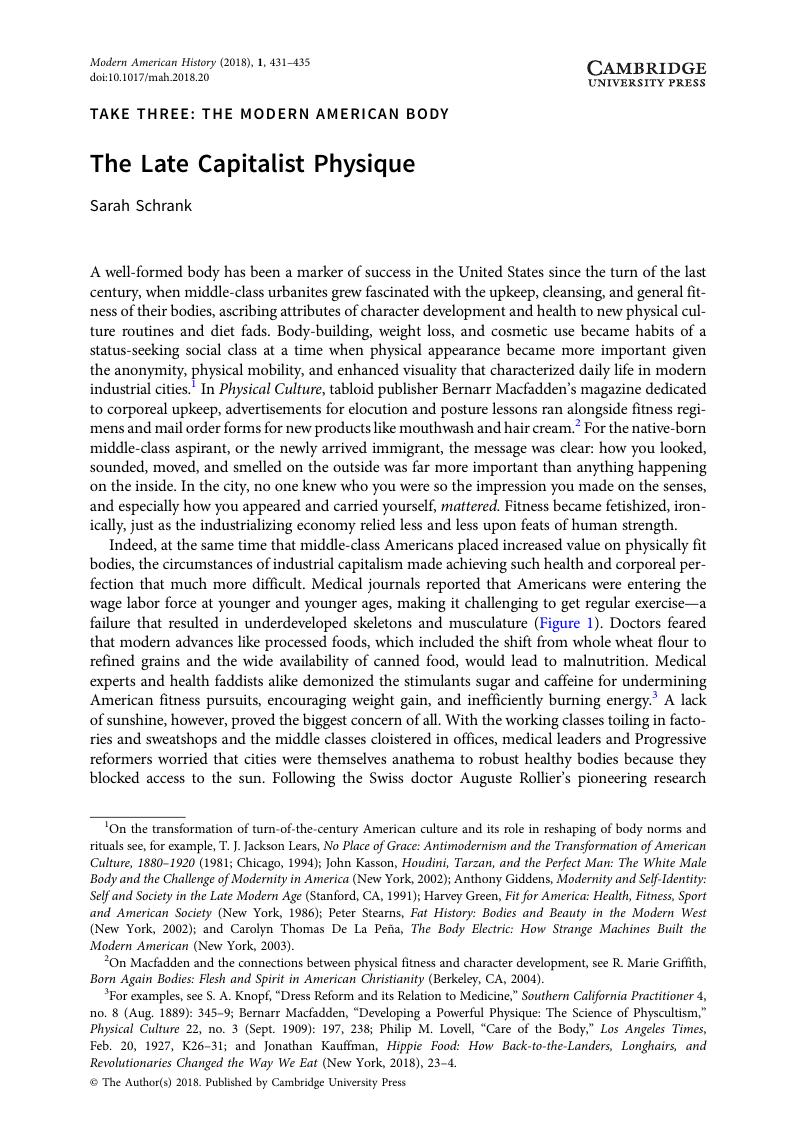Published online by Cambridge University Press: 11 June 2018

1 On the transformation of turn-of-the-century American culture and its role in reshaping of body norms and rituals see, for example, Lears, T. J. Jackson, No Place of Grace: Antimodernism and the Transformation of American Culture, 1880–1920 (1981; Chicago, 1994)Google Scholar; Kasson, John, Houdini, Tarzan, and the Perfect Man: The White Male Body and the Challenge of Modernity in America (New York, 2002)Google Scholar; Giddens, Anthony, Modernity and Self-Identity: Self and Society in the Late Modern Age (Stanford, CA, 1991)Google Scholar; Green, Harvey, Fit for America: Health, Fitness, Sport and American Society (New York, 1986)Google Scholar; Stearns, Peter, Fat History: Bodies and Beauty in the Modern West (New York, 2002)Google Scholar; and De La Peña, Carolyn Thomas, The Body Electric: How Strange Machines Built the Modern American (New York, 2003)Google Scholar.
2 On Macfadden and the connections between physical fitness and character development, see Griffith, R. Marie, Born Again Bodies: Flesh and Spirit in American Christianity (Berkeley, CA, 2004)CrossRefGoogle Scholar.
3 For examples, see Knopf, S. A., “Dress Reform and its Relation to Medicine,” Southern California Practitioner 4, no. 8 (Aug. 1889): 345–9Google Scholar; Macfadden, Bernarr, “Developing a Powerful Physique: The Science of Physcultism,” Physical Culture 22, no. 3 (Sept. 1909): 197, 238Google Scholar; Philip M. Lovell, “Care of the Body,” Los Angeles Times, Feb. 20, 1927, K26–31; and Kauffman, Jonathan, Hippie Food: How Back-to-the-Landers, Longhairs, and Revolutionaries Changed the Way We Eat (New York, 2018), 23–4Google Scholar.
4 On Rollier's sun therapies and the 1927 medical identification of sunshine as a source of vitamin D, see Sadar, John Stanislav, “Material Heliotechnics: A Tale of Two Bodies,” in Healing Spaces, Modern Architecture and the Body, eds. Schrank, Sarah and Ekici, Didem (London, 2017), 65–84Google Scholar. For a discussion of the relationship between early twentieth-century urban reform and concerns about middle-class access to the sun, see Schrank, Sarah, Free and Natural: Naked Living and the American Cult of the Body (Philadelphia, forthcoming 2019)Google Scholar.
5 See Hau, Michael, The Cult of Health and Beauty in Germany: A Social History, 1890–1930 (Chicago, 2003)Google Scholar; Ross, Chad, Naked Germany: Health, Race, and the Nation (Oxford, UK, 2005)Google Scholar; Williams, John Alexander, Turning to Nature in Germany: Hiking, Nudism, and Conservation, 1900–1940 (Stanford, CA, 2007)Google Scholar; and Hoffman, Brian, Naked: A Cultural History of American Nudism (New York, 2015)Google Scholar.
6 For instance, see Briggs, Laura, “The Race of Hysteria: ‘Overcivilization’ and the ‘Savage’ Woman in Late Nineteenth-Century Obstetrics and Gynecology,” American Quarterly 52, no. 2 (June 2000): 246–73CrossRefGoogle ScholarPubMed; McKenzie, Shelly, Getting Physical: The Rise of Fitness Culture in America (Lawrence, KS, 2013)Google Scholar; and Ehrenreich, Barbara, Hearts of Men: American Dreams and the Flight from Commitment (New York, 1983)Google Scholar.
7 Cederström, Carl and Spicer, André, The Wellness Syndrome (Cambridge, UK, 2015), 26–9Google Scholar.
8 Orenstein, Peggy, Girls and Sex: Navigating the Complicated New Landscape (New York, 2016)Google Scholar.